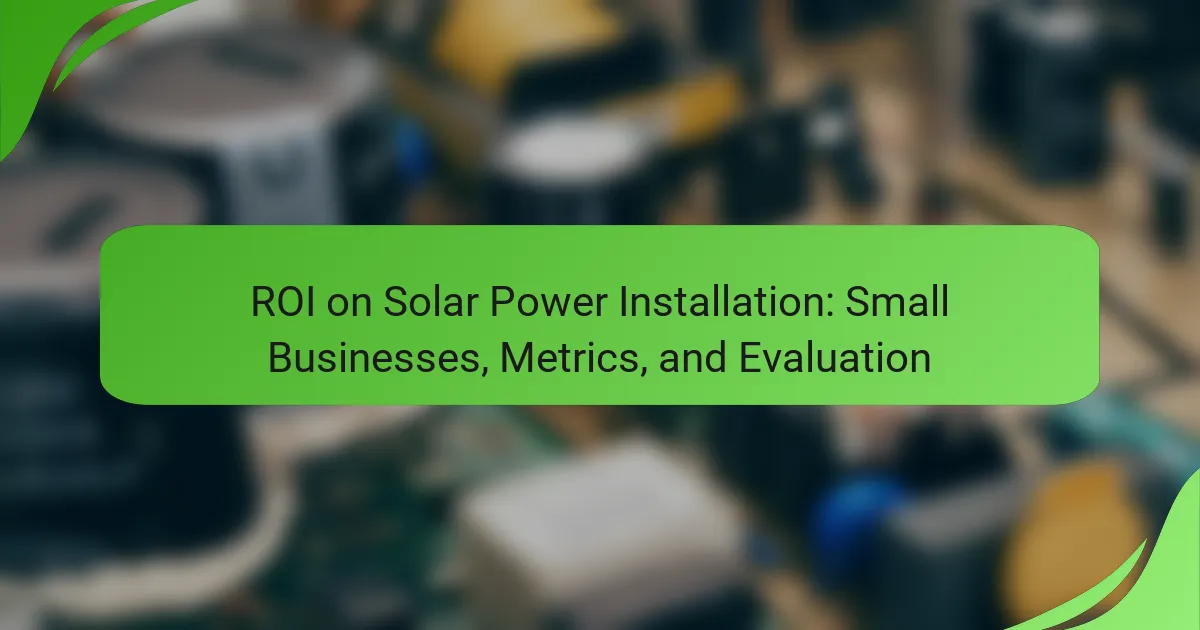Small businesses can significantly benefit from evaluating the return on investment (ROI) of solar power installations by analyzing various financial metrics. Key factors such as cost savings, energy production, and available incentives play a crucial role in determining the viability and long-term advantages of adopting solar energy. By understanding these metrics, businesses can make informed decisions that enhance their sustainability and financial performance.
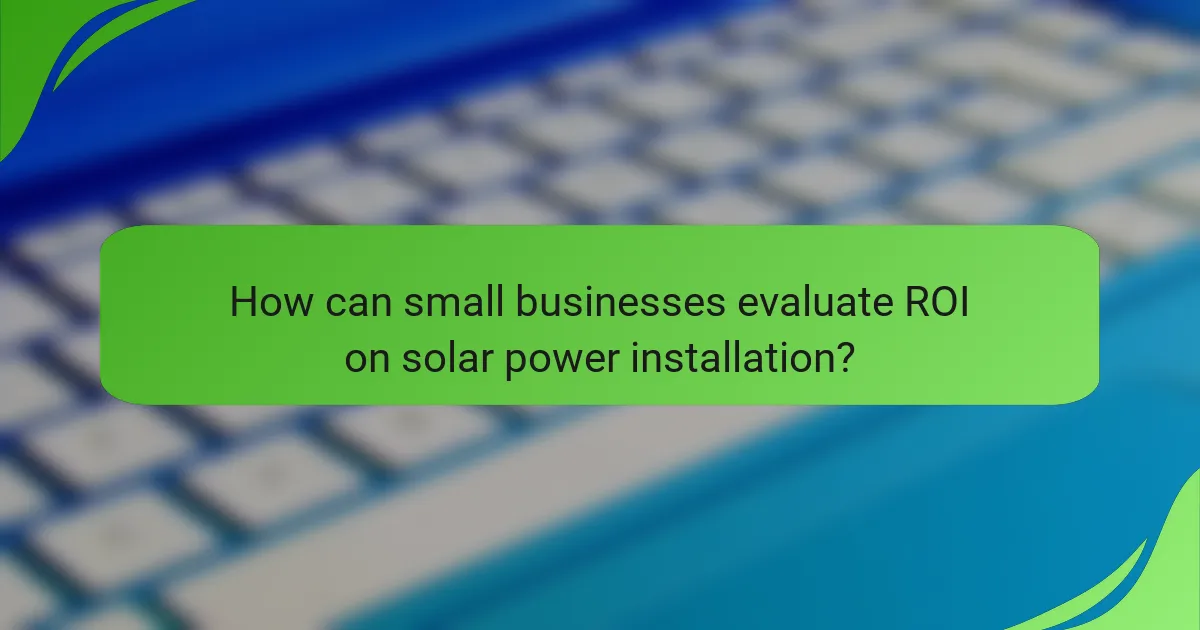
How can small businesses evaluate ROI on solar power installation?
Small businesses can evaluate the return on investment (ROI) for solar power installations by analyzing cost savings, energy production, payback periods, tax incentives, and financing options. Understanding these metrics helps determine the financial viability and long-term benefits of solar energy adoption.
Cost savings analysis
Cost savings analysis involves calculating the reduction in electricity bills after installing solar panels. Businesses should compare their current energy costs with projected savings, which can often reach 20-50% annually, depending on local electricity rates and solar system efficiency.
Additionally, consider maintenance costs and potential increases in energy prices over time. A thorough analysis should factor in these variables to provide a clearer picture of long-term savings.
Energy production metrics
Energy production metrics focus on the amount of electricity generated by the solar installation. This is typically measured in kilowatt-hours (kWh) and can be influenced by factors such as system size, location, and weather conditions.
Small businesses should review historical data from similar installations in their area to estimate expected energy output. Monitoring tools can also help track real-time production, ensuring the system operates at optimal efficiency.
Payback period calculation
The payback period is the time it takes for the savings from solar energy to equal the initial investment. For small businesses, this period typically ranges from 5 to 10 years, depending on installation costs and energy savings.
To calculate the payback period, divide the total installation cost by the annual savings. This metric is crucial for understanding how quickly a business can expect to recoup its investment.
Tax incentives impact
Tax incentives can significantly enhance the ROI of solar installations. In many regions, businesses can benefit from federal and state tax credits, which can cover a substantial portion of the installation costs.
For example, in the United States, the federal solar tax credit allows businesses to deduct a percentage of the installation cost from their federal taxes. Understanding local incentives is essential for accurately assessing the financial impact of solar energy investments.
Financing options
Financing options for solar installations can affect the overall ROI. Small businesses can explore various financing methods, including loans, leases, and power purchase agreements (PPAs).
Each option has different implications for cash flow and tax benefits. For instance, a loan may allow for ownership and tax credits, while a lease may provide lower upfront costs but limit tax advantages. Evaluating these options helps businesses choose the best path for their financial situation.
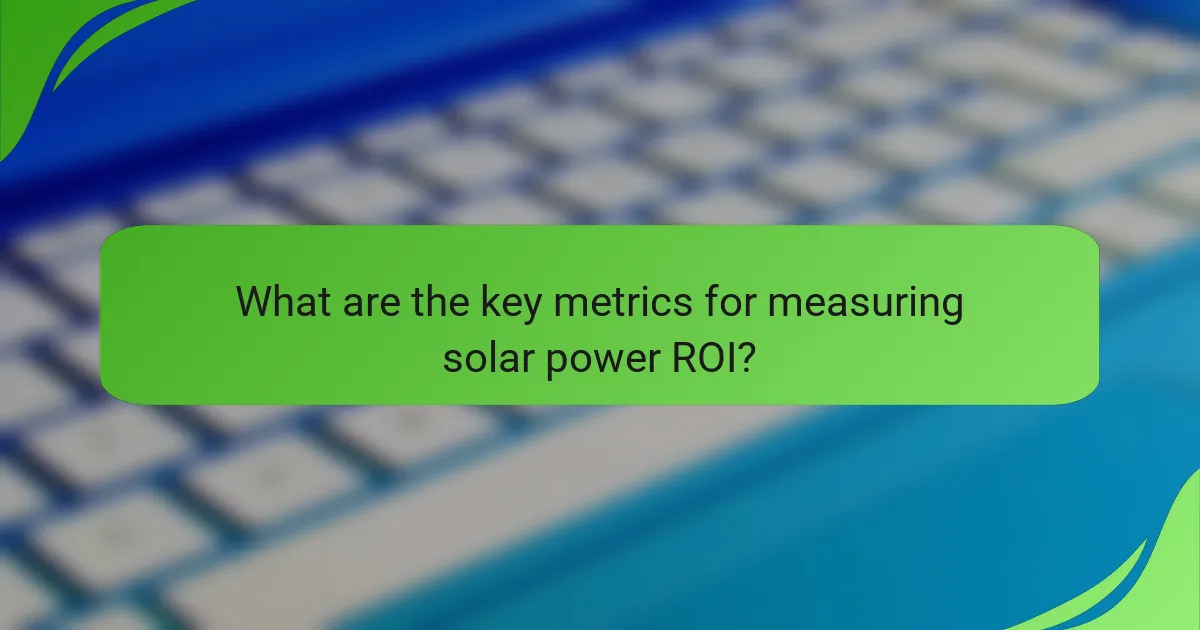
What are the key metrics for measuring solar power ROI?
The key metrics for measuring solar power ROI include initial investment costs, annual energy savings, system performance ratio, and net present value. These metrics help small businesses evaluate the financial benefits and efficiency of their solar power installations.
Initial investment costs
Initial investment costs refer to the total expenses incurred to purchase and install a solar power system. This includes the price of solar panels, inverters, mounting hardware, and installation labor. For small businesses, these costs can vary widely, typically ranging from several thousand to tens of thousands of USD depending on system size and complexity.
When assessing initial costs, consider available incentives such as tax credits, rebates, or grants that can significantly reduce the upfront financial burden. It’s essential to obtain multiple quotes from reputable installers to ensure competitive pricing.
Annual energy savings
Annual energy savings represent the reduction in electricity bills resulting from solar power generation. By switching to solar, small businesses can often save anywhere from 20% to 50% on their energy costs, depending on local electricity rates and system performance.
To calculate annual savings, monitor your utility bills before and after installation. Additionally, consider the potential for rising energy prices, which can further enhance the financial benefits of solar energy over time.
System performance ratio
The system performance ratio (PR) measures the efficiency of a solar power system by comparing actual energy output to the expected output under ideal conditions. A PR of 75% to 85% is generally considered good for most commercial systems, indicating effective energy production.
Factors affecting the performance ratio include shading, orientation, and maintenance. Regular inspections and cleaning can help maintain optimal performance, ensuring that the system operates efficiently and maximizes ROI.
Net present value
Net present value (NPV) calculates the profitability of the solar investment by considering future cash flows from energy savings and any associated costs, discounted back to their present value. A positive NPV indicates that the investment is likely to be profitable over its lifespan.
To determine NPV, estimate future energy savings over the expected life of the solar system, typically around 25 years. Include maintenance costs and potential increases in energy prices, as these factors can significantly influence the overall financial outcome.

What factors influence solar power ROI for small businesses in California?
The return on investment (ROI) for solar power installations in California is influenced by several key factors, including state incentives, local electricity rates, and the variability of installation costs. Understanding these elements can help small businesses make informed decisions about investing in solar energy.
State incentives and rebates
California offers various incentives and rebates that can significantly enhance the ROI of solar power systems for small businesses. Programs such as the California Solar Initiative provide cash rebates based on the size of the solar installation, while the federal Investment Tax Credit (ITC) allows businesses to deduct a substantial percentage of the installation costs from their federal taxes.
Additionally, local utility companies may offer their own incentives, such as performance-based incentives or net metering programs, which can further improve financial returns. Small businesses should research available incentives to maximize their savings.
Local electricity rates
The cost of electricity in California is among the highest in the United States, making solar power an attractive option for small businesses looking to reduce their energy expenses. By generating their own electricity, businesses can offset their utility bills, leading to quicker payback periods and improved ROI.
Understanding the local electricity rates and how they fluctuate can help businesses estimate their potential savings. For instance, businesses in areas with higher rates may see a more significant financial benefit from solar installations compared to those in regions with lower rates.
Installation costs variability
Installation costs for solar power systems can vary widely based on factors such as system size, equipment quality, and labor expenses. In California, the average installation cost can range from $2.50 to $4.00 per watt, depending on these variables.
Small businesses should obtain multiple quotes from different solar providers to compare costs and ensure they are getting a competitive price. It’s also essential to consider the long-term benefits of higher-quality equipment, which may have a higher upfront cost but can lead to greater efficiency and savings over time.
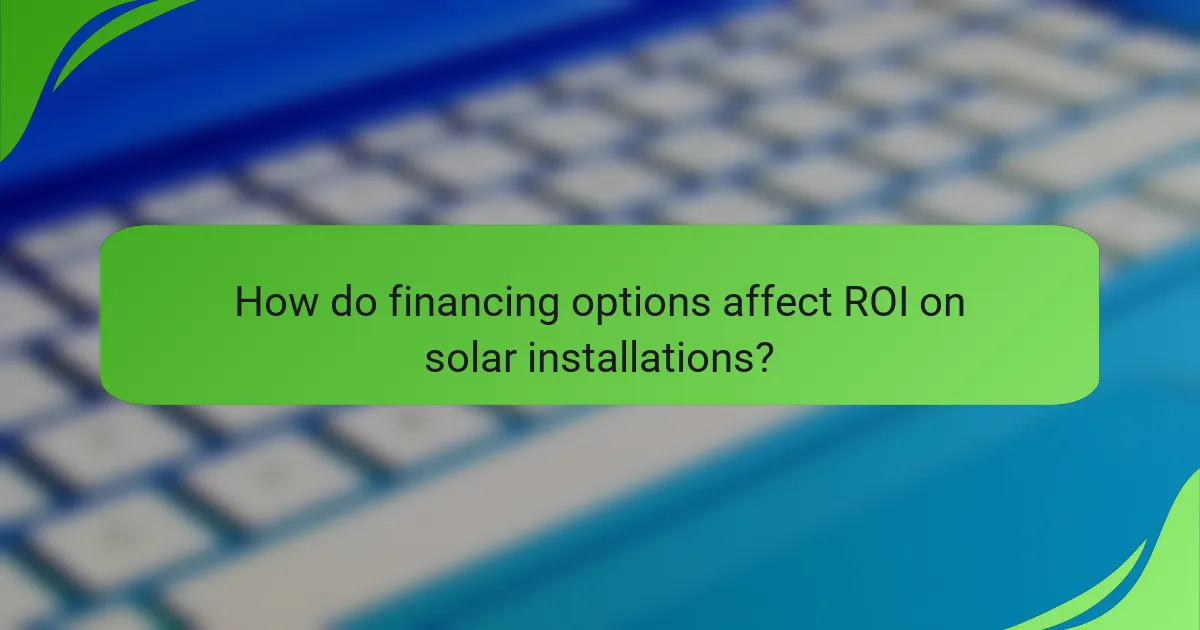
How do financing options affect ROI on solar installations?
Financing options significantly influence the return on investment (ROI) for solar installations by affecting upfront costs, monthly payments, and overall savings. Choosing the right financing method can enhance cash flow and maximize long-term financial benefits for small businesses.
Loan vs. lease comparison
When comparing loans and leases for solar installations, loans typically require a larger upfront payment but allow for ownership of the system, leading to greater long-term savings. In contrast, leases often have lower initial costs and fixed monthly payments, but the business does not own the system and may miss out on tax incentives.
For example, a loan may result in a total cost of ownership that yields savings of 20-30% over the system’s lifespan, while a lease might offer immediate cash flow benefits but limit overall financial gains. Businesses should evaluate their cash flow, tax situation, and long-term goals when deciding between these options.
Impact of PACE financing
Property Assessed Clean Energy (PACE) financing allows small businesses to fund solar installations through property tax assessments, spreading the cost over time. This method can improve ROI by enabling businesses to install solar systems without significant upfront costs, as payments are made through property taxes.
PACE financing often comes with favorable terms, such as long repayment periods and low-interest rates, making it an attractive option for businesses looking to enhance their energy efficiency. However, businesses should ensure they understand the implications of increased property taxes and potential resale impacts.
Cash purchase benefits
Purchasing a solar system outright with cash provides the highest ROI since it eliminates financing costs and allows businesses to take full advantage of tax credits and incentives. By owning the system, businesses can enjoy immediate savings on energy bills and avoid monthly payments.
For instance, a cash purchase can lead to a payback period of 5-7 years, after which the energy savings contribute directly to the bottom line. However, businesses should assess their liquidity and financial health before committing to a cash purchase, as it requires significant upfront capital.
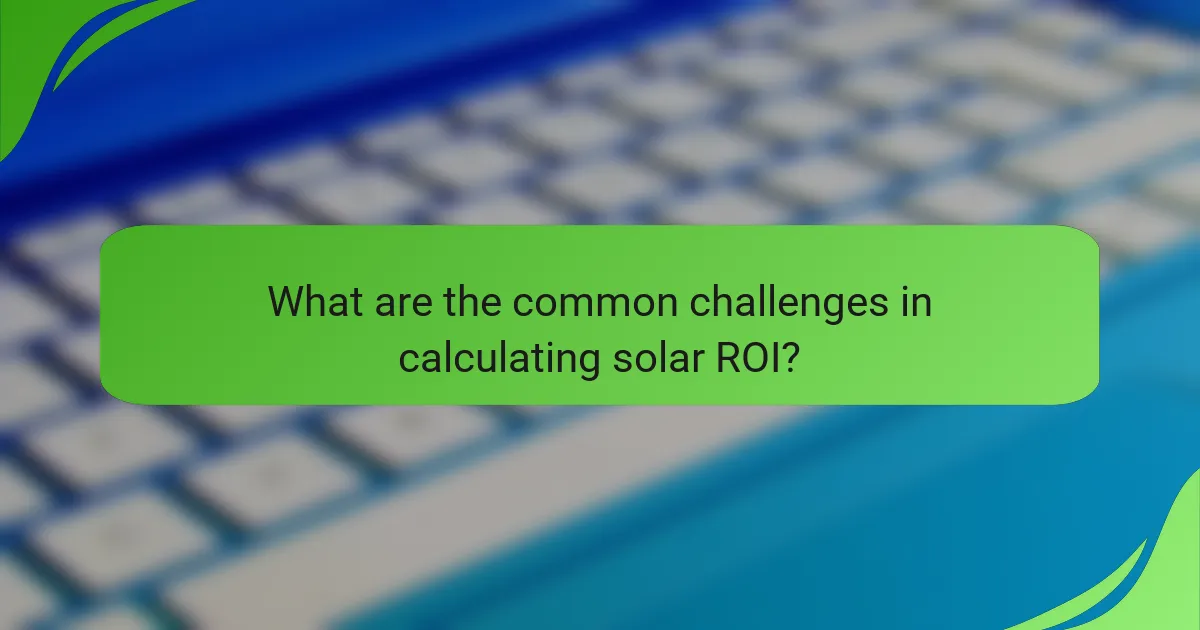
What are the common challenges in calculating solar ROI?
Calculating the return on investment (ROI) for solar power installations can be complex due to various factors that influence financial outcomes. Small businesses often face challenges such as fluctuating energy prices, varying installation costs, and the impact of local incentives or regulations.
Fluctuating Energy Costs
Energy prices can vary significantly over time, affecting the savings generated from solar power. When calculating ROI, it’s essential to consider both current and projected energy rates. For instance, if energy costs rise, the savings from solar can increase, improving ROI.
Installation Costs
The initial costs of solar installation can differ widely based on system size, technology, and local labor rates. Small businesses should obtain multiple quotes to understand the range of installation costs. This helps in creating a more accurate financial model for ROI calculations.
Incentives and Rebates
Local, state, and federal incentives can significantly impact the ROI of solar installations. These may include tax credits, rebates, or grants that reduce upfront costs. Businesses should research available incentives in their area, as they can vary greatly and affect overall financial returns.
Maintenance and Operational Costs
While solar systems generally require low maintenance, occasional repairs or replacements can incur costs. Businesses should factor in these potential expenses when estimating ROI. A well-maintained system can lead to better performance and savings over time.
Financing Options
Different financing methods, such as loans, leases, or power purchase agreements (PPAs), can influence ROI calculations. Each option has its own cost structure and implications for cash flow. Understanding these options allows businesses to choose the best financing method for their situation.
